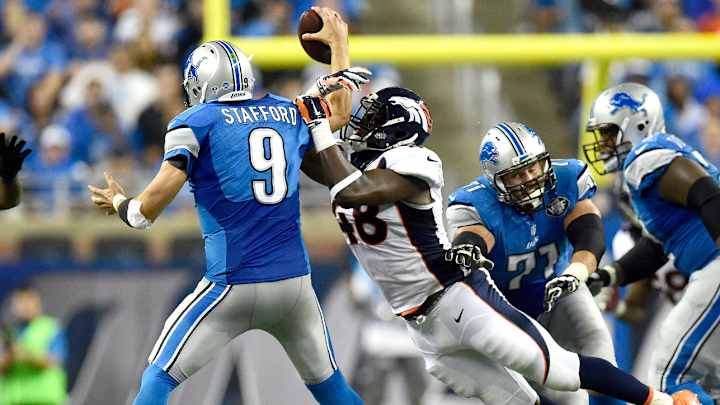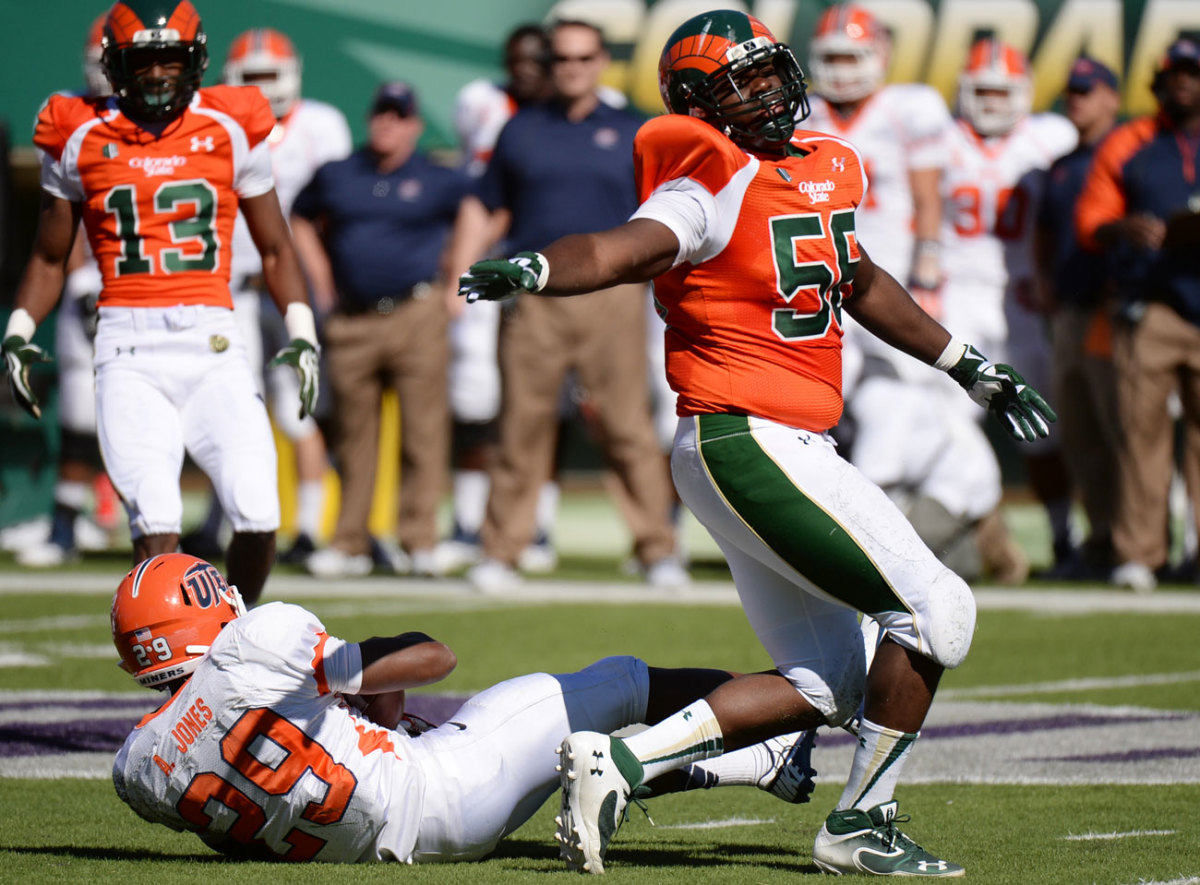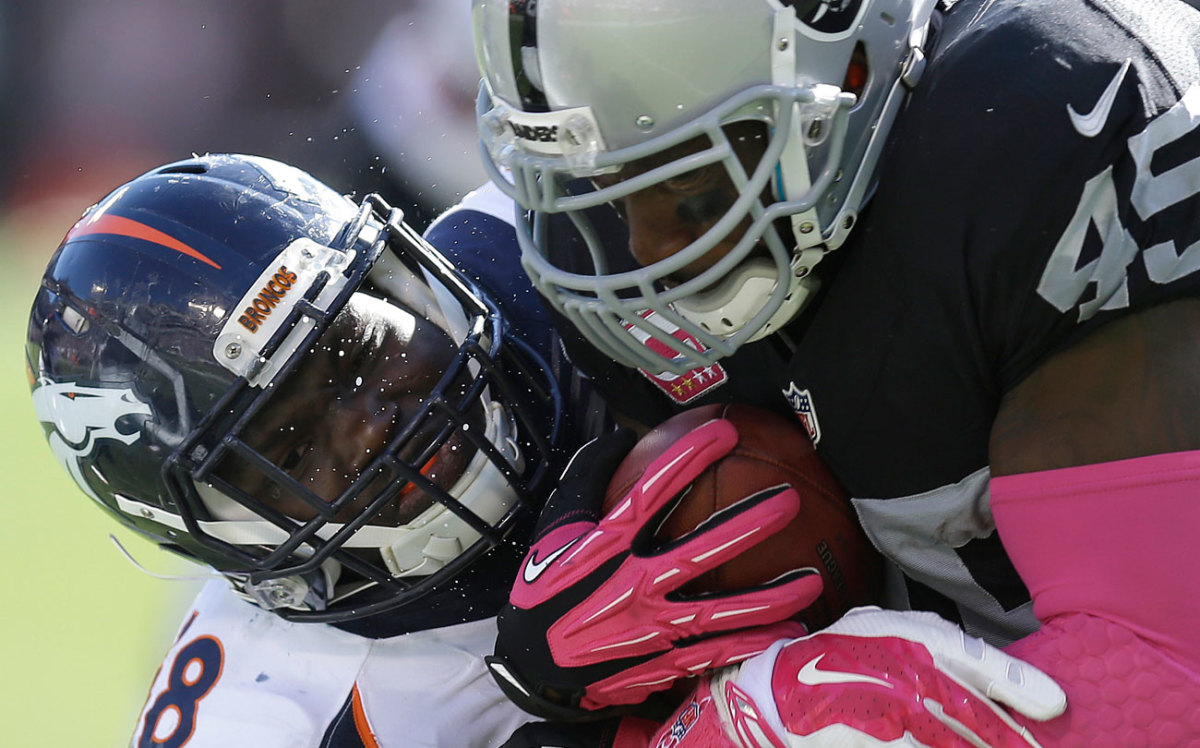Shaquil Barrett Shapes Up

ENGLEWOOD, Colo. — Shaquil Barrett remembers vividly the weigh-in at the 2014 East-West Shrine Game in St. Petersburg, Fla. You strip down to your compression shorts, wait to hear your name called, walk across a stage and stand on a scale to be weighed and thoroughly picked over by the prying eyes of middle-aged men. Barrett believed he’d made a lasting impression that week, and he was right, though not for the reasons he imagined.
Two years removed from Colorado State and now with the Broncos, Barrett was browsing social media early this season when the Timehop app alerted him to a years-old photo of himself oozing out of a skin-tight dark green No. 56 jersey.
Serious muffin top.
“I didn’t realize how bad I was until I saw that picture,” he says. "How come nobody told me I looked like that?”
Nobody had to tell Barrett why he wasn’t drafted a year ago; teams were scared off by his 24% body fat as a 6-1, 250-pound rush linebacker. The Broncos asked him to sign as a free agent and stashed him on the practice squad last season while he transformed his body. Eighteen months later Barrett is emerging as a playmaker on a defense full of them. He’s expected to get his second start this weekend against the Chiefs in place of the injured DeMarcus Ware.

“It’s great for a coach because he’s the example,” says Broncos coach Gary Kubiak. “You use him as an example when you’re trying to keep your young guys going, trying to keep a backup going. You say, look at what he’s done for this team. You never know when your opportunity’s going to come.”
Barrett’s opportunity came late last month against the Browns. Ware was injured, and it was widely assumed that rookie Shane Ray, the 23rd overall pick in the 2015 draft, would get the start at outside linebacker. But the staff couldn’t deny Barrett, who’d been impressive in a limited role to that point—13 tackles, two sacks and two forced fumbles in 97 snaps—and he cashed in on the opportunity, collecting nine tackles, 1.5 sacks, three tackles for loss, a forced fumble and a fumble recovery against Cleveland.
The question was raised more than once: What’s this guy been eating? Turns out the mild-mannered linebacker’s success in 2015 has more to do with what he’s not eating.
“In college I put sugar on my spaghetti or lasagna,” Barrett says, drawing out the ‘ah’ sound in ‘college’ in a manner specific to Baltimore, where he grew up. “That’s why I have to stay away from pasta, because the only way I can eat it is with sugar.”
Ok, but how much sugar?
“I think I used to put like seven packs of sugar on spaghetti to make it taste edible.”
Oh no.
“Yes.”
• SLEEP STRATEGIES: Jenny Vrentas on the NFL’s hottest new performance enhancer
Barrett thought nothing of it at the time; nutrition wasn’t a priority for him at Colorado State (he didn’t meet a dietician until senior year), and it wasn’t a priority in his household either. Barrett transferred to Colorado State from Nebraska-Omaha after his freshman season in 2011 and brought along his now-wife, Jordanna. They were married in a Colorado courthouse and had their first of three children that winter.
Jordanna worked steady jobs in food service, including a run at Starbucks in Fort Collins, to support the family. Barrett was getting scholarship assistance from Boys Town, the boarding school in Omaha where his working-class parents sent him and his brother as teenagers. (Barrett says he was unmotivated at City High in Baltimore.) The $5,000 scholarship was a fine supplement until CSU put him on full scholarship, requiring he no longer receive outside aid. With Jordanna working nights and Barrett having no intention of cooking anything more complicated than a burger, he turned to fast food—McDonald’s and Wendy’s were favorites—and when she did cook meals they were typically fried, or, after Barrett had his say, drowned in sugar.
“The college budget and a healthy diet don’t really fit, because the healthy food always costs more,” Barrett says. “And it wasn’t really what we were thinking about. We always paid the rent first so we’d at least have a roof.”
“He’s desperate to succeed, to survive. Guys like that make this league.”
Under those circumstances, Barrett collected 12 sacks as a Colorado State senior and set a Mountain West record with 20.5 tackles for loss. That winter his new agent and former bodybuilder Edy Jackson wrote up a nutrition plan and enlisted Jordanna to execute the meals. Well on his way to a healthier lifestyle, he arrived in Denver the next summer and met with one of the few full-time dieticians employed by an NFL team to evaluate his diet.
“We have one-on-one consultations with new players during training camp, and I have them walk me through a typical day,” says Bryan Snyder, Denver’s full-time registered dietician since 2009. “With Shaq it was about balancing his diet and portion control.
“With some players it takes a couple of weeks to start the process. I met with Shaq in the morning, and at the end of the day, after he lifted, he came to me like, where’s my recovery shake? He was holding me accountable.”
• MIDSEASON ALL-PRO TEAM: Andy Benoit picks the standouts at the halfway point
Seeing Barrett grab the bull by the horns is something everyone at Broncos HQ would soon get used to. “The job is never too big for him,” says linebacker Von Miller. “I admire that about him. He’s got three kids so, he never gets rattled.”
Says linebacker Danny Trevathan: “He’s desperate to succeed, to survive, to make it. Guys like that make this league.”

That Barrett landed on an NFL team with the proper resources to remedy his particular shortcoming was something of a dice roll. By Snyder’s count, only 12 teams have full-time dieticians on staff (the group meets at each combine, when schedules permit). When Snyder got the job in 2009, the Broncos put Snyder in a small office far away from the cafeteria and continued to outsource meals to local caterers for five years, until the team built a kitchen space and hired chefs during the 2014 season.
“Before we had our own kitchen, we would lose guys,” Snyder says. “By November, 10 or 15 guys would be getting fast food for lunch. This year I’ve only seen outside food brought in one time, and I think it was a make-the-rookie-go-get-food situation. The credit goes to [team president] Joe Ellis and [GM] John Elway and Mr. [Pat] Bowlen to free up the resources to do it right.”
Barrett’s daily intake now consists of the following: Egg-beaters, oatmeal and turkey bacon for breakfast (a meal he rarely ate in school), some combination of fish, chicken and salad for lunch and dinner, and two protein shakes provided by Snyder’s staff and customized to each player.
His body fat for the last 15 weeks: 11.5%, down from 24% at his worst at Colorado State.
• SEARCHING FOR TOM BRADY: One fan’s years-long mission to meet the Pats’ QB
Barrett says the physical transformation gave him a quicker burst and increased muscle mass, allowing him to concentrate on the finer points of pass rushing. He’s fourth on the team in sacks with 3.5, half a sack behind both Miller and Malik Jackson and three behind leader DeMarcus Ware. The Broncos rank No. 1 in yards and points allowed due in no small part to the depth provided by unheralded linemen Derek Wolfe and Vance Walker, defensive backs Bradley Roby and David Bruton, and Barrett, who spends a chunk of his time studying Miller and Ware on film and mimicking their trademarked moves.
“Von has a speed, stutter, bull-swipe kind of move that he gets a lot of sacks with, Barrett says. “I can do it in practice, but I haven’t done it effectively in games. D. Ware—when he rushes, he’s technical with it. He’s got his steps down, and his steps will match his hands every time.”
While Miller and Ware are the headliners, Denver’s defense is crowded with homegrown, diamond-in-the-rough success stories. Chris Harris Jr., a second-team All-Pro last season, was undrafted out of Kansas in 2011. Trevathan, who led the team in tackles in 2013 before fracturing his kneecap last August, was chosen in the sixth round out of Kentucky in 2012.

“We can’t all be drafted in the first round,” Trevathan says. “Having guys like Shaq is what makes a team great. He wasn’t pictured to be a playmaker, but he stepped up.”
If he hadn’t, and football hadn’t worked out—as it often doesn’t for UDFAs— Barrett says he probably would’ve been a police officer. He and Jordanna might still be carefully budgeting funds just to make rent, and Jordanna might not get the second wedding they’re planning in February 2016—the real deal this time, with 200-plus guests and formal wear for the Barrett brood. Embracing the diet plan and giving up the sugar buffet was a matter of necessity, not choice.
“I had to,” Barrett says. “I wanted to give myself the best shot I could to make an impact on the team. I see it as an opportunity to give my family a great life.”
